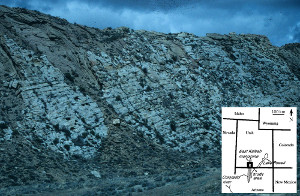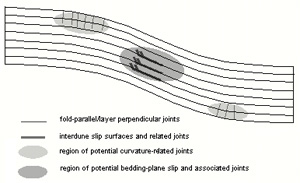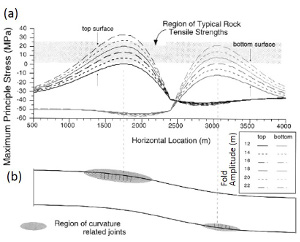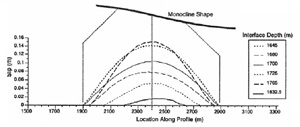| |||||||
|
|
|||||||
|
|
|||||||
| Fractures in E. Kaibab Monocline, UT-AZ, USA | |||||||
|
Perhaps, one of the simplest deformational structures is that of monoclines. Surprisingly, there is not a lot of work done in this type of structures as far as fracturing in the monoclines is concerned. Reches (1976) presented one of the most comprehensive study of fractures in two monoclines in Israel. Later, Cooke (1996), Mollema and Aydin (1997), and Cooke et al. (2000) characterized and mapped joint clusters and bedding slip-based faults within the Mesozoic sandstone formations within the East Kaibab Monocline, Utah. Figure 1 is a photograph of a highly tilted pavement showing bed-perpendicular and strike-prallel and dip-parallel joint sets, north of Hwy 89. Figure 2 shows a cross-section views with excellent examples of bed-parallel shearing and related splay fractures oblique to bedding.
Fold-axis parallel and bedding oblique joints, shown in Figure 2, are inferred to be the splays of dune boundary slip, or sheared bedding-based faults. The regions prone to bedding-prallel slip along the bed interfaces occurs along the steeply dipping limb of the fold and in the middle of the layer (Figure 3). The bedding perpendicular and fold-axis parallel joints are inferred to have formed by bending-related stresses along the outer arc of the fold. The growth potential of those joints can be assessed by the maximum principle stress induced by the folding, which increases with fold amplitude. Figure 4 shows a plot of the calculated maximum principle stresses along a bended layer. Along the top surface of the fold, the highest stresses occur at the crest of the anticline; while along the fold's bottom surface, at the trough of the syncline. Also shown in Figure 5, while the fold shape is symmetric, the potential for joint growth is not. The large compressive lithostatic loads along the bottom surface of the fold decreases the maximum principal stress in the trough of the syncline relative to that in the crest of the anticline, so the maximum principal stress is greater in the anticlinal hinge than in the synclinal hinge. The case illustrates the importance of bedding plane slip during the flexture of multi-layers. Slip along interlayers effectively decouples layers allowing greater folding amplitude and may produce clusters of joints. Knowledge of the variation in layer thickness in a sequence is thus crucial and can be used to infer the sequence and pattern of slip along layer interfaces. Knowing the mechanical stratigraphy of rock strata, the contribution of both fold curvature and bedding plane slip to joint occurrence and localization can be evaluated. It is also important to consider the basement faults responsible for the monoclinal folding of the sedimentary cover. To this end, please see Fischer and Christensen (2004). These models provide the framework for predicting the location, orientation, and localization of sub-surface fracture distributions in monoclinal structures. In summary, two types of joint clusters were documented as idealized in an 2D section in Figure 3: those perpendicular to bedding and parallel to the fold axis, and those parallel or perpendicular to the fold axis and oblique to bedding associated with bedding plane slip. The former occurs predominantly within the synclinal hinge of the monocline, while the latter occurs along the steeply dipping limb of the fold and within the middle of the formation. | |||||||
| Reference: |
|||||||
| Cooke, M., 1996 Cooke, M., Mollema, P., Pollard, D.D., Aydin, A., 2000 Fischer, M.P., Christensen, R.D., 2004 Mollema, P., Aydin, A., 1997 Reches, Z., 1976 |
|||||||
|
Readme | About Us | Acknowledgement | How to Cite | Terms of Use | Ⓒ Rock Fracture Knowledgebase |
|||||||




